Cendol
|
| |
| Alternative names | Chendol, dawet (Central and East Java), lot chong (Thailand), bánh lọt (Vietnam), mont let saung (Burma) |
|---|---|
| Type | Dessert |
| Region or state | South East Asia |
| Main ingredients | Coconut milk, rice flour jelly with pandan leaves juice, shaved ice, palm sugar |
Cendol /ˈtʃɛndɒl/ is an iced sweet dessert that contains droplets of worm-like green rice flour jelly,[1] coconut milk and palm sugar syrup.[2] It is commonly found in Southeast Asia and is popular in Indonesia,[3][4] Malaysia,[5] Singapore, Brunei, Cambodia, East Timor, Vietnam, Thailand, and Burma. Next to the green jelly, additional toppings might be added, including diced jackfruit, sweetened red azuki beans,[6] or durian.[7]
Etymology
The word "cendol" was first mentioned in 1932 as one of the foodstuffs available in Kuala Lumpur as recorded in the Malay Concordance Project that collects Malay writings.[8][9] Dawet is claimed to be the origin of cendol; the Javanese name of "dawet" was recorded in early 19th century Javanese manuscript of Serat Centhini, composed between 1814-1823 in Surakarta, Central Java.[10] In Java, dawet refer to the whole concoction of cendol green jellies, usually made from aren sagoo or rice flour, coconut milk and liquid gula jawa (palm sugar syrup),[11] sometimes sliced jackfruit might be added.[12]
There is a popular belief that the name "cendol" is related to, or originated from, the word jendol, in reference to the swollen green worm-like rice flour jelly;[9] in Javanese, Sundanese, Indonesian, and Malay, jendol means "bump," "bulge,"[13] or "swollen."[14] In most parts of Indonesia, cendol refer to the green rice flour jelly; while the concoction of that green rice flour jellies with coconut milk, shaved ice, areca palm sugar and sometimes diced jackfruit is called es cendol or dawet (in Central and East Java).
Indonesian dictionary describes cendol as a snack made from rice flour and other ingredients that are formed by filters, then mixed with palm sugar and coconut milk (for beverage).[15] The Malay dictionary Kamus Dewan similarly defines it as a porridge-like drink with long strands made of rice flour in coconut milk and sugar syrup.[16]
In Vietnam, this worm-like rice flour concoction is called bánh lọt or "fall through cake". Bánh lọt is a common ingredient in a Vietnamese dessert drink called chè, or more commonly chè ba màu. In Thailand it is called lot chong (Thai: ลอดช่อง, pronounced [lɔ̂ːt t͡ɕʰɔ̂ŋ]) which can be translated as "gone through a hole", indicating the way it is made by pressing the warm dough through a sieve into a container of cold water.[17] In Burma it is known as mont let saung or မုန့်လက်ဆောင်း. In Cambodia, it is known as lot (លត /lɔːt/), bang-aem lot (បង្អែមលត /bɑŋʔaɛm lɔːt/), nom lot (នំលត /nɷm lɔːt/), and banh lot (បាញ់លត /baɲ lɔːt/).
History
The origin of cendol is not clear, and this sweet drink is widely spread across Southeast Asia. However, one suggestion is that cendol originated in Java, Indonesia as dawet. In Banjarnegara, Central Java, dawet is traditionally served without ice. Today, however additional ice cubes or shaved ice is commonly added into this dessert drink.[18] This might suggest that in tropical Java, dawet is a traditional sweet dessert drink that predates the adoption of refrigeration technology. Cendol is typically served with ice, and developed when ice became readily available. It may have originated in Malayan port cities such as Malacca and Penang where British refrigerated ships' technology would provide the required ice.[19]
In Javanese tradition, dawet or cendol is a part of traditional Javanese wedding ceremony. The dodol dawet (Javanese for "selling dawet") is performed during Midodareni ceremony, a day before the wedding. After the siraman bridal shower, the parents would sell dawet to the attending guests and relatives. The guest paid the dawet using terracotta coins that would be given to the bride as a symbol of family earnings. The symbolic meaning was as the parents' hope that the tomorrow wedding would be attended by a lot of guests, "as plenty as the cendol jellies that being sold."[20] In Dutch East Indies Java, dawet street hawkers using pikulan (baskets carried with balancing rod) are commonly found in Javanese cities, as can be seen in the old photograph dated from circa 1935.
Cendol has been declared a Malaysian heritage food by the Malaysian Department of National Heritage.[21]
Ingredients
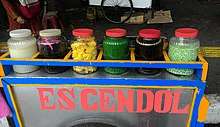
The ingredients of cendol relies heavily on aren (sugar palm) and coconut plants.[22] The dessert's original or basic ingredients are coconut milk, jelly noodles made from rice flour with green food coloring (usually derived from the pandan leaf), shaved ice, and palm sugar. The cendol in Indonesia is usually served in a tall glass, assembled with liquid gula jawa or palm sugar syrup in the bottom, followed by green jellies, poured with coconut milk, and topped with shaved ice.
The Singaporean and Malaysian versions usually have sweetened red beans added, and are served in a bowl instead of a glass. The palm sugar, often added as a dark syrup, is referred to as gula melaka.[6]
In Sunda, Indonesia, cendol is a dark-green pulpy dish of rice (or sago) flour worms with coconut milk and syrup of areca sugar. In Javanese, cendol refers to the green jelly-like part of the beverage, while the combination of cendol, palm sugar and coconut milk is called dawet. Today, the green cendol jelly noodles are mainly made from rice flour, since rice is more readily available. However, in Java, a traditional cendol worm-like jelly noodles was made from sagu aren, or sago starch extracted from the trunk of sugar palm (Arenga pinnata).[22]
In Indonesia, additional ingredients might include tapai (fermented sweet cassava), black grass jelly, and sweetened condensed milk. In Indonesia and Thailand, cendol usually served in tall glass, in Malaysia and Singapore however, they usually served in a bowl.
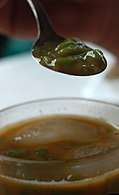 Cendol in Indonesia refer to the green jellies
Cendol in Indonesia refer to the green jellies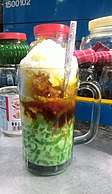 A glass of Jakarta street-side es cendol
A glass of Jakarta street-side es cendol.jpg) A glass of simpler Thai lot chong
A glass of simpler Thai lot chong Vietnamese chè ba màu with beans
Vietnamese chè ba màu with beans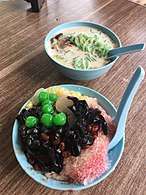 Chendol in Malaysia with red beans
Chendol in Malaysia with red beans- A bowl of chendol sold in Singapore
Vietnamese chè ba màu adds white black-eyed peas and red azuki beans together with green jellies. Thai lot chong is closer to the Javanese original, only consisting of green worm-like jellies, coconut milk, liquid palm sugar, and shaved ice.
Variants
In Indonesia, the most famous variant is Javanese es dawet ayu from Banjarnegara, Central Java.[22](p16) Another variant is a black cendol called es dawet ireng from Purworejo, Central Java. Ireng is Javanese word for "black". Instead of green pandan leaf, this black cendol acquired its color from merang or the ash of burned rice stalk mixed with water.[22]
Other than basic ingredients of green jelly noodles, palm sugar syrup, and coconut milk; iced cendol might be served with additional toppings. Additional topping includes diced jackfruit, tapai (fermented sweet cassava), durian flesh, and chocolate condensed milk are popular in Indonesia.[7] While in Malaysia, additional topping such as red beans, glutinous rice, grass jelly, creamed corn, might also be included.[23]
The influence of Singapore and the West has given rise to different variations of cendol, such as cendol with vanilla ice-cream or topped with durian.[24]
Selling
Cendol has become a quintessential part of cuisine in Southeast Asia and is often sold by vendors at roadsides, hawker centres, and food courts.[25] Cendol vendors are almost ubiquitous in Indonesian cities, especially Jakarta, Bandung, and Yogyakarta. Originally cendol or dawet in Java was served without ice, but after the introduction of refrigeration technology, the cold cendol with shaved ice (es serut) was available and widely popular.
In Indonesia and Malaysia, cendol is commonly sold on the roadside by vendors. It is even dessert fare in Singapore, found in dessert stalls, food centres, coffee shops, and food courts.[25]
In popular culture
In colloquial Indonesian, the term "cendol" has become an online rating system. If an online items tweaks interest, a user punch in one or more green commas resembling a cendol.[13]
Cendol is also one of the Indonesian food items made popular by Barack Obama during his Indonesian visit in 2017. Obama stated that during his visit he had a lot of Indonesian food including satay, bakso, tempeh, and nasi goreng, but he missed es cendol and es kelapa muda, thus he determined to have them in his last afternoon in Indonesia.[26][27]
See also
References
- ↑ Jane Freiman (19 May 1986). "Underground Gourmet: Sampling Indonesia". New York Magazine. p. 119.
- ↑ Witton, Patrick (2002). Indonesia, Lonely planet: World food. Lonely Planet. p. 141. ISBN 9781740590099.
- ↑ Indonesian Desserts: Cendol, Kolak, Es Kacang Hijau, Es Teler, Es Bir. General Books LLC. 2010. ISBN 9781158259595.
- ↑ "Recipe: Es cendol". Belindo.
- ↑ "Shaving the Ice, Cutting the Heat".
- 1 2 Brunton, John (28 May 2017). "Nice ice: A traditional take on Malaysia's favourite dessert". The Guardian.
- 1 2 "Es Cendol Durian". Femina (in Indonesian).
- ↑ "Pekan Hari Ahad Di Kampung Baru, Kuala Lumpur" (in Malay).
- 1 2 "Cendol". ifood.TV. Archived from the original on 14 July 2014. Retrieved 10 June 2014.
- ↑ "Kuliner Tempo Dulu Versi Serat Centhini". Serat Centhini (in Indonesian). 2009-11-19. Retrieved 2018-05-28.
- ↑ Pringgoharjono, Kestity (2006). The Centhini Story: The Javanese Journey of Life : Based on the Original Serat Centhini. Marshall Cavendish. ISBN 9789812329752.
- ↑ Post, The Jakarta. "Ramadhan recipe: The Dharmawangsa Jakarta's 'es dawet'". The Jakarta Post. Retrieved 2018-05-28.
- 1 2 Christopher Torchia; Lely Djuhari (2012). Indonesian Slang: Colloquial Indonesian at Work. Tuttle Publishing. ISBN 9781462910571.
- ↑ Google translate, jendol
- ↑ "Cendol". KBBI (in Indonesian).
- ↑ "cendol". Dewan Bahasa dan Pustaka.
- ↑ "Lod Chong Recipe". Thaifoodmaster.com.
- ↑ "Resep Dawet Ayu". Zona Makan (in Indonesian).
- ↑ Anita Isalska (1 March 2018). The World's Best Bowl Food: Where to find it and how to make it. Lonely Planet Food. ISBN 9781787019218.
- ↑ "Rumitnya Upacara Adat Pernikahan Solo". Kompas.com (in Indonesian). 23 May 2011.
- ↑ "Malaysian Intangible Heritage Objects". Archived from the original on 2015-04-02.
- 1 2 3 4 Rian Yulianto W. Minuman Tradisional Indonesia (in Indonesian). Gulajava Ministudio. pp. 16, 21.
- ↑ Penang Food | Cendol | The Best Penang Hawker Food and Restaurant Guide Archived December 29, 2010, at the Wayback Machine.
- ↑ VisitSingapore.com - Chendol
- 1 2 My Asian Kitchen: Cendol
- ↑ Abba Gabrillin (1 July 2017). "Obama Masih Penasaran dengan Es Cendol dan Es Kelapa Muda". Kompas.com (in Indonesian).
- ↑ "Obama Penasaran dengan Es Cendol - Liputan6 Petang". Liputan6 Petang SCTV via Youtube.
External links
| Wikimedia Commons has media related to Cendol. |
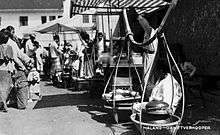
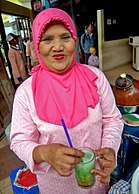

.jpg)